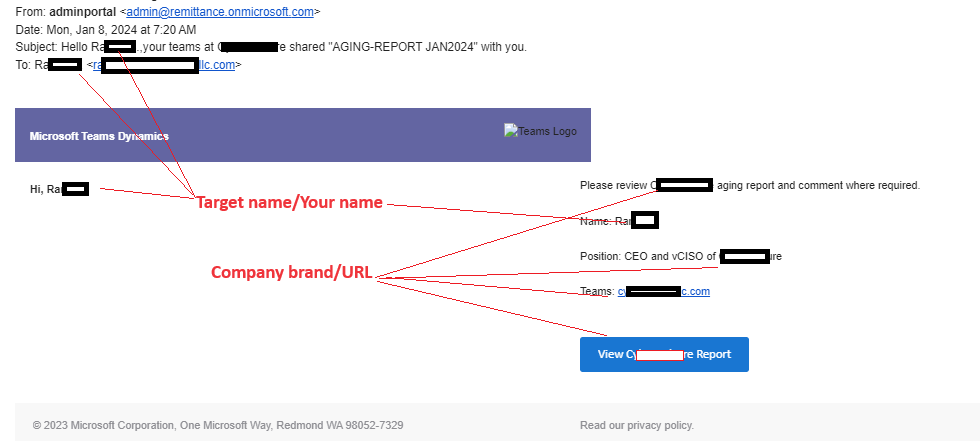In the ever-evolving landscape of cyber threats, small businesses find themselves increasingly vulnerable to sophisticated phishing campaigns. One such recent threat has emerged in 2024, targeting users of Microsoft Teams—a widely used collaboration platform.
Phish Email Campaign
On January 8, 2024, we detected a targeted email campaign aimed at the CEO/Founder of a small business. The email includes the recipient’s name and their company title, with an attempt to entice them to click on a phishing link disguised as a document shared by a team member for the year 2024 on the MS Teams platform. Figure 1 illustrates the email campaign specifically targeting small businesses.

Upon clicking on the “View [company name] report”, the user would be redirected to a phishing landing page as shown below.

Upon examining the URL, the phishing attempt becomes apparent. However, for a regular user not acquainted with phishing indicators, their initial inclination might be to instinctively click on the “Enter Microsoft Teams” button. Figure 3 illustrates the credential harvesting page that appears once the button is clicked.

Understanding the Threat
Phishing attacks have become more cunning and targeted, and this latest Microsoft Teams phishing campaign is no exception. Cybercriminals are leveraging the widespread adoption of collaboration tools, exploiting the trust users place in platforms like Microsoft Teams to gain unauthorized access and compromise sensitive information.
Deceptive Emails
Attackers often initiate the phishing campaign through seemingly legitimate emails. These messages may mimic official Microsoft Teams notifications, prompting users to click on malicious links or download infected attachments.
Fake Login Pages
The attackers create convincing replicas of Microsoft Teams login pages, tricking users into entering their credentials. These fake pages may be hosted on compromised websites or specially crafted domains resembling the official Microsoft Teams site.
What We Recommend
Employee Awareness Training: Educate your employees about the latest phishing threats and the importance of verifying the authenticity of emails, especially those related to Microsoft Teams.
Multi-Factor Authentication (MFA): Enable MFA for all accounts to add an additional layer of security. Even if credentials are compromised, MFA helps prevent unauthorized access.
Regular Security Audits: Conduct regular security audits to identify vulnerabilities and address them promptly. This includes reviewing user permissions, monitoring account activity, and ensuring that all security features are up to date.
Email Filtering and Security Software: Implement advanced email filtering and security solutions to detect and block phishing emails before they reach users’ inboxes.
Reporting and Incident Response: Encourage employees to report suspicious emails promptly. Establish an incident response plan to address potential security incidents swiftly and effectively.
Conclusion
The threat landscape is constantly evolving, and small businesses must remain vigilant against sophisticated phishing campaigns. By staying informed about the latest threats, implementing robust security measures, and fostering a culture of cybersecurity awareness, businesses can mitigate the risks associated with the Microsoft Teams phishing campaign and protect their valuable data from falling into the wrong hands.





